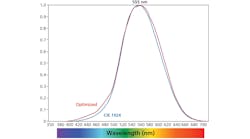The device is a 1-mm² thin-film InGaAlP chip, emitting at a dominant wavelength of 615 nm. The prototype chip was tested in a Golden Dragon Plus package. The overall efficiency is 44% at 350 mA and 49% at 70mA. The value exceeds 50% for a wavelength of 642 nm.
“This will benefit all applications that use high-efficiency red, particularly projection applications,” said Wolfgang Schmid, who is responsible for developing this chip technology at OSRAM Opto Semiconductors. “We expect to start equipping LED products with the new thin-film chips in about a year’s time.”
Wolfgang Lex, Head of the LED business unit at Osram Opto Semiconductors, told LEDs Magazine that the improvements were the result of a focused internal project to improve the performance of red LEDs. “The project looked for barriers,” said Lex, “and resulted in an improved epitaxial process.”
Another consequence is that the new prototype red LEDs have a reduced temperature dependence. “For InGaAlP LEDs there is usually a very quick drop-off of light output when hot, much more so than for InGaN LEDs,” said Lex. This can be particularly important for automotive applications, for example.
While the improvements to Osram’s red LEDs came about as a result of a planned research project, green LED performance experienced a great leap forward when a blue LED chip was combined with a phosphor developed by 3M, resulting in record efficacy for a green LED.
Unfortunately, says Lex, the phosphor contains cadmium, which creates environmental issues, and also lacked stability with temperature. However, he said, the discovery “opened the door” and Osram has now developed a Cd-free phosphor with much better temperature stability.
The performance improvements for both red and green LEDs, coupled with high-performance blue LEDs already in production, should open up new markets. In projection, for example, these devices can enable efficient projectors embedded in mobile handsets, or much larger stand-alone projectors, expanding the market beyond the current “pocket-projector” niche.






